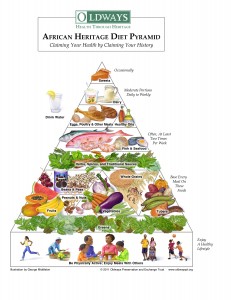SNAP Into The Old Ways
January 17, 2012“Eating well” means eating the healthiest foods that we love to eat most. It does not mean eating foods that we don’t like simply because they are healthy, nor does it mean eating foods we love that don’t provide the nutrition our bodies need. SNAP’s wonderful new initiative to help us “SNAP To Health” makes it easier to purchase foods that are good for us and taste great, like fruits, vegetables, and whole grains.
But, how do we eat these healthy foods happily? What are some ways to prepare meals in nutritious ways, without losing the flavor? And how do you decide which new healthy foods might be your favorites?
Oldways believes that the answer lies in heritage.
Oldways was created to help people to eat well, to eat with pleasure, and to eat culturally and traditionally—habits that add up to a wonderful way to live, full of enjoyment and well-being. We looked back at the healthy dietary traditions of populations that enjoyed widespread vitality and health, and what we found were delicious foods: pastas and paella, gumbo and sushi, salsas and ratatouille—inspiring dishes with mouthwatering spices and flavors and a healthy showcase of vegetables.
Health conditions like diabetes, heart disease, and obesity were either very rare or totally unknown in earlier times, much because of the way that people traditionally ate and the physical activities they participated in. Our ancestors didn’t choose to eat these ways for nutrition necessarily, but for the pleasure of these hearty foods and in the spirit of their cultures. Nutrition was simply a natural, positive side effect; and, it can be this way again. The delicious foods and eating patterns of these populations can be found in Oldways’ traditional diet pyramids: the Mediterranean, Asian, Latin American, Vegetarian, and—our newest model—the African Heritage Diet Pyramid.
The African Heritage Diet Pyramid just launched publicly in November 2011. It is based on the traditional eating and lifestyle patterns of the African Diaspora, spanning across Africa, parts of South America, the Caribbean, and the American South. These traditions encompassed foods bursting with exciting tastes and aromas, and just as exciting, they are affordable to buy and easy and fun to make today.
Like all of Oldways’ pyramids, the African Heritage Pyramid is a plant-based model – promoting familiar and exotic vegetables and fruits, nuts and seeds, whole grains, beans and peas, and earthy tubers like sweet potatoes and yams in abundance; seafood and healthy oils often; and, meats, sweets, and dairy in moderation. This guide will lead you and your grocery cart (or farmer’s market basket!) to load up on staples like leafy greens, cowpeas and cabbage, and healthy tubers in the spirit of African Heritage. Our website has many African Heritage recipes dishes from the four major African Diasporan regions, as well as an African Heritage Diet 101 Brochure that briefly describes the history and heritage of this diet, the health benefits of eating this way, and tips for making small changes and carving a new outlook on food.
If you’re inspired by these old ways of eating, you can use all of the pyramids to shape your week. To follow the Mediterranean Pyramid, use your SNAP card to purchase whole grain pasta and fresh garlic, healthy hummus for sandwiches and dipping vegetables, or a bottle of olive oil that can last your family for months (It is much more affordable than you might guess!). The Latin American Pyramid might add whole cornmeal, avocados, black beans (or frijoles), and papayas to your cart. Our Asian Pyramid may inspire you to try the delicious bok choy vegetable or pickled ginger.
To help you even more in your grocery shopping, the Mediterranean and African Heritage Diet Pyramids have their own grocery lists and guides on setting up your “health heritage” kitchens. The Latin American Pyramid has resources in both English and Spanish.
Traditional diets have many things in common, especially the pleasure of whole grains. Oldways also created The Whole Grains Council to focus specifically on this extraordinary food group. The Whole Grain Stamp can be found on close to 6,000 products worldwide, and they’re a regular face in grocery stores. Products that contain whole grains and wear the Stamp make it easier for you to pick them out on the shelves.
With a new year on the rise, Oldways invites you and your family to enjoy the foods and plant-based eating patterns of traditional diets, be it your own culture or others. Let your food sing with the flavors of tradition, so that we can all start to reclaim health by reclaiming heritage, with the old ways as our guide.
by Sarah Dwyer, Program Manager, Oldways
Comments are closed.
